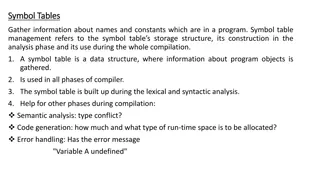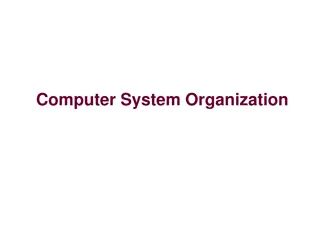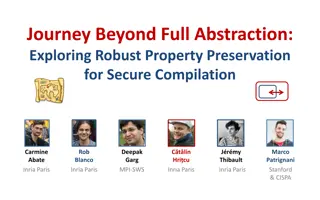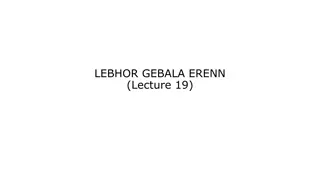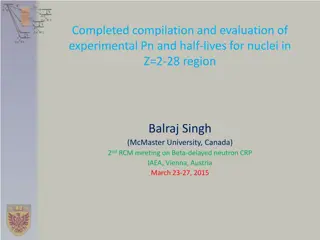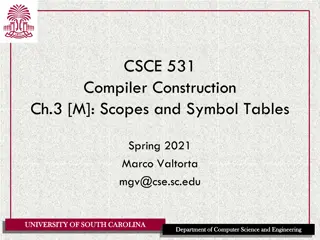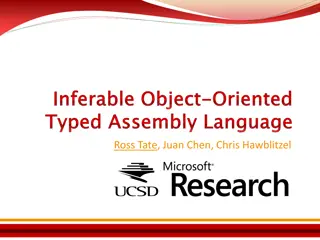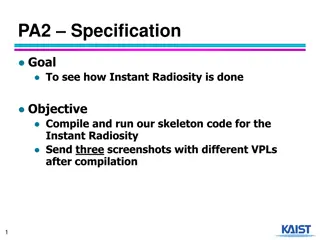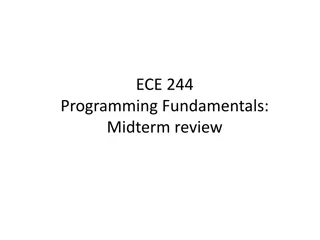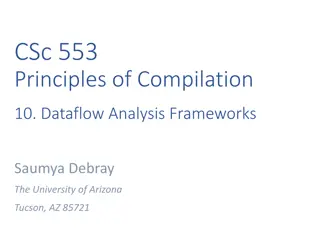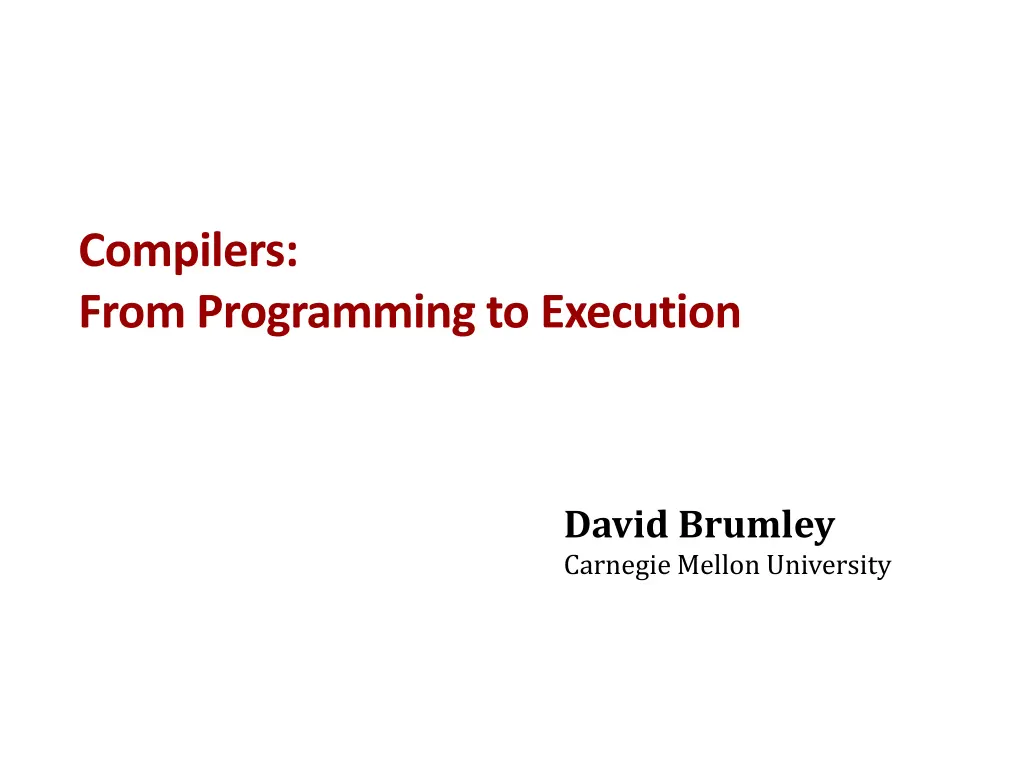
Understanding Compilation Process in Programming
Dive into the world of compilers and interpreters with insights on translating C code, machine models, and key concepts. Explore the compilation workflow, target languages, and pre-compiler stages to grasp how code is transformed into executable instructions. Discover the significance of stack frames, registers, and the x86 execution model.
Download Presentation

Please find below an Image/Link to download the presentation.
The content on the website is provided AS IS for your information and personal use only. It may not be sold, licensed, or shared on other websites without obtaining consent from the author. If you encounter any issues during the download, it is possible that the publisher has removed the file from their server.
You are allowed to download the files provided on this website for personal or commercial use, subject to the condition that they are used lawfully. All files are the property of their respective owners.
The content on the website is provided AS IS for your information and personal use only. It may not be sold, licensed, or shared on other websites without obtaining consent from the author.
E N D
Presentation Transcript
Compilers: From Programming to Execution David Brumley Carnegie Mellon University
To answer the question Is this program safe? We need to know What will executing this program do? 3
What will executing this program do? #include <stdio.h> void answer(char *name, int x){ printf( %s, the answer is: %d\n , name, x); } void main(int argc, char *argv[]){ int x; x = 40 + 2; answer(argv[1], x); } 42.c 4
void answer(char *name, int x){ printf( %s, the answer is: %d\n , name, x); } void main(int argc, char *argv[]){ int x; x = 40 + 2; answer(argv[1], x); } Compilation 0011010 1101010 1000101 David The compiler and machine determines the semantics the semantics The compiler and machine determines David, the answer is: 42 5
Input Compiled Code Target Language Source Language Compilation Output 6
Interpreted Code Source Language Output Interpretation Input 7
Today: Overview of Compilation 1. How is C code translated to executable code? 2. What is the machine model for executing code? 8
Key Concepts Compilation workflow x86 execution model Endian Registers Stack Heap Stack frames 9
Target Language 42 in x86 Source Language Compilation 42.c in C Pre- Compiler (cc1) Assembler (as) Linker (ld) processor (cpp) 42.c 42 11
Pre- Compiler (cc1) Assembler (as) Linker (ld) processor (cpp) #include <stdio.h> void answer(char *name, int x){ printf( %s, the answer is: %d\n , name, x); } ... $ cpp #include expansion #define substitution 12
Pre- Compiler (cc1) Assembler (as) Linker (ld) processor (cpp) #include <stdio.h> void answer(char *name, int x){ printf( %s, the answer is: %d\n , name, x); } ... $ gcc -S Creates Assembly 13
gcc S 42.c outputs 42.s _answer: Leh_func_begin1: pushq %rbp Ltmp0: movq %rsp, %rbp Ltmp1: subq $16, %rsp Ltmp2: movl %esi, %eax movq %rdi, -8(%rbp) movl %eax, -12(%rbp) movq -8(%rbp), %rax .... 14
Pre- Compiler (cc1) Assembler (as) Linker (ld) processor (cpp) _answer: Leh_func_begin1: pushq %rbp Ltmp0: movq %rsp, %rbp Ltmp1: subq $16, %rsp Ltmp2: movl %esi, %eax movq %rdi, -8(%rbp) movl %eax, -12(%rbp) movq -8(%rbp), %rax .... $ as <options> 42.s Creates object code 15
Pre- Compiler (cc1) Assembler (as) Linker (ld) processor (cpp) 0101100101010101101010101 1010101010101010111111100 0011010101101010100101011 0101111010100101100001010 10111101 $ ld <options> 42.o Links with other files and libraries to produce an exe 16
Disassembling Today: using objdump (part of binutils) objdump D <exe> If you compile with -g , you will see more information objdump D S Later: Disassembly 17
The program binary (aka executable) Binary Code Segment (.text) Final executable consists of several segments Text for code written Read-only data for constants such as hello world and globals ... Data Segment (.data) ... $ readelf S <file> 18
Basic Execution Fetch, decode, execute Binary Code Data Processor ... Stack Heap read and write Process Memory File system 20
x86 Processor Address of next instruction EAX EDX ECX Condition codes EIP EBX EFLAGS ESP EBP General Purpose ESI EDI 21
Registers have up to 4 addressing modes EAX EDX 1. Lower 8 bits 2. Mid 8 bits 3. Lower 16 bits 4. Full register ECX EBX ESP EBP ESI EDI 22
EAX, EDX, ECX, and EBX AX EAX AH AL EAX EDX DH DL DX EDX ECX CX CL ECX CH EBX BH BL BX EBX Bit 32 16 15 0 Bit 32 16 15 8 7 0 32 bit registers (three letters) Lower bits (bits 0-7) (two letters with L suffix) Mid-bits (bits 8-15) (two letters with H suffix) Lower 16 bits (bits 0-15) (2 letters with X suffix) 23
ESP, EBP, ESI, and EDI SP ESP AH AL EAX EBP DH DL BP EDX ESI SI CL ECX CH EDI BH BL DI EBX Bit 32 16 15 0 Lower 16 bits (bits 0-15) (2 letters) 24
Basic Ops and AT&T vs Intel Syntax destination first source first Meaning ebx = eax eax = eax + ebx ecx = ecx << 2 AT&T movl %eax, %ebx mov ebx, eax addl %ebx, %eax add eax, ebx shl $2, %ecx Intel shl ecx, 2 AT&T is at odds with assignment order. It is the default for objdump, and traditionally used for UNIX. Intel order mirrors assignment. Windows traditionally uses Intel, as is available via the objdump -M intel command line option 25
x86: Byte Addressable ... It s convention: lower address at the bottom I can fetch bytes at any address Address 3 holds 1 byte Address 2 holds 1 byte Memory is just like using an array! Address 1 holds 1 byte Address 0 holds 1 byte Alternative: Word addressable Example: For 32-bit word size, it s valid to fetch 4 bytes from Mem[0], but not Mem[6] since 6 is not a multiple of 4. 27
x86: Addressing bytes Addr Addresses are indicated by operands that have a bracket [] or paren () , for Intel vs. AT&T, resp. What does mov dl, [al] do? 0xff 6 0xee 0xdd 0xcc Moves 0xcc into dl 0xbb Register eax edx ebx Value 0x3 0x0 0x5 0xaa 0x00 0 28
x86: Addressing bytes Addr Addresses are indicated by operands that have a bracket [] or paren () , for Intel vs. AT&T, resp. What does mov edx , [eax] do? 0xff 6 0xee 0xdd 0xcc 0xbb Which 4 bytes get moved, and which is the LSB in edx? Register eax edx ebx Value 0x3 0xcc 0x5 0xaa 0x00 0 29
Endianess Endianess: Order of individually addressable units Little Endian: Least significant byte first Addr 0xff 6 0xee 0xdd so address a goes in littlest byte (e.g., AL), a+1 in the next (e.g., AH), etc. 0xcc 0xbb Register eax edx ebx Value 0x3 0xcc 0x5 0xaa 0x00 0 30
mov edx, [eax] EDX Addr 0xff 0xff 6 Register eax edx ebx Endianess: Ordering of individually addressable units Little Endian: Least significant byte first ... so ... address a goes in the least significant byte (the littlest bit) a+1 goes into the next byte, and so on. Value 0x3 0xcc 0x5 Bit 0 0xee 0xee EDX = 0xffeeddcc! 0xdd 0xdd 0xcc 0xcc 0xbb 0xaa 0x00 0 31
mov [eax], ebx EBX Addr 00 00 00 00 00 00 05 05 0xff 6 Register eax edx ebx Endianess: Ordering of individually addressable units Little Endian: Least significant byte first ... so ... address a goes in the least significant byte (the littlest bit) a+1 goes into the next byte, and so on. Value 0x3 0xcc 0x5 Bit 0 0xee 0xdd 0xcc 0xbb 0xaa 0x00 0 32
There are other ways to address memory than just [register]. These are called Addressing Modes. An Addressing Mode specifies how to calculate the effective memory address of an operand by using information from registers and constants contained with the instruction or elsewhere. 33
Motivation: Addressing Buffers Type buf[s]; buf[index] = *(<buf addr>+sizeof(Type)*index) 34
Motivation: Addressing Buffers 0 0 0 3 0 0 0 2 0 0 0 1 typedef char *addr_t; uint32_t w, x, y, z; uint32_t buf[3] = {1,2,3}; addr_t ptr = (addr_t) buf; buf[2] Memory w = buf[2]; x = *(buf + 2); What is x? what memory cell does it ref? buf 35
Motivation: Addressing Buffers 0 0 0 3 0 0 0 2 0 0 0 1 typedef char *addr_t; uint32_t w, x, y, z; uint32_t buf[3] = {1,2,3}; addr_t ptr = (addr_t) buf; buf[2] Memory w = buf[2]; x = *(buf + 2); y = *( (uint32_t *) (ptr+8)); Equivalent (addr_t) (ptr + 8) = (uint32_t *) buf+2 buf 36
Motivation: Addressing Buffers Type buf[s]; buf[index] = *(<buf addr>+sizeof(Type)*index) Constant scaling factor s, typically 1, 2, 4, or 8 Say at imm +r1 Say in Register r2 imm + r1 + s*r2 AT&T: imm (r1, r2, s) Intel: r1 + r2*s + imm 37
AT&T Addressing Modes for Common Codes Form imm (r) imm (r1, r2) imm (r1, r2, s) imm Meaning on memory M M[r + imm] M[r1 + r2 + imm] M[r1 + r2*s + imm] M[imm] 38
Referencing Memory Loading a value from memory: mov mov -0x38(%ebp),%eax (I) mov eax, [ebp-0x38] (A) <eax> = *buf; Loading an address: lea lea -0x38(%ebp),%eax (I) lea eax, [ebp-0x38] (A) <eax> = buf; 39
Suppose I want to access address 0xdeadbeef directly Loads the address lea eax, 0xdeadbeef (I) Deref the address mov eax, 0xdeadbeef (I) Note ATT also has missing $ for addresses. This distinguishes the address from the value.(Can you find out what it is for intel syntax?) 40
Control Flow 41
Assembly is Spaghetti Code Nice C Abstractions if-then-else while for loops do-while Assembly Jump Direct: jmp addr Indirect: jmp reg Branch Test EFLAG if(EFLAG SET) goto line 42
Jumps jmp 0x45, called a direct jump jmp *eax , called an indirect jump x86 Processor EAX EDX EFLAGS ECX EBX EIP Branches if (EFLAG) jmp x Use one of the 32 EFLAG bits to determine if jump taken ESP EBP Note: No direct way to get or set EIP ESI EDI 43
Implementing if C Psuedo-Assembly 1. Computing x y. Set eflags: 1. CF =1 if x < y 2. ZF =1 if x==y 2. Test EFLAGS. If both CF and ZF not set, branch to E 3. mov x, z 4. Jump to F 5. mov y, z 6. <end of if-then-else> 1. if(x <= y) 2. z = x; 3. else 4. z = y; Assembly is 2 instrs 1. Set eflag to conditional 2. Test eflag and branch 44
if(x <= y) eax holds x and 0xc(%ebp) holds y cmp 0xc(%ebp), %eax ja addr Same as sub instruction r = %eax - M[ebp+0xc], i.e., x y Jump if CF=0 and ZF=0 x > y (x>=y) (x!=y) 45
Setting EFLAGS Instructions may set an eflag, e.g., cmp and arithmetic instructions most common Was there a carry (CF Flag set) Was the result zero (ZF Flag set) What was the parity of the result (PF flag) Did overflow occur (OF Flag) Is the result signed (SF Flag) 46
Aside: Although the x86 processor knows every time integer overflow occurs, C does not make this result visible. From the Intel x86 manual 47
See the x86 manuals available on Intel s website for more information Instr. JO JNO JS JZ JE JL JLE JB JP Description Jump if overflow Jump if not overflow Jump if sign Jump if zero Jump if equal Jump if less than Jump if less than or equal Jump if below Jump if parity Condition OF == 1 OF == 0 SF == 1 ZF == 1 ZF == 1 SF <> OF ZF ==1 or SF <> OF CF == 1 PF == 1 48
0xC0000000 (3GB) user stack %esp Memory Program text Shared libs Data ... Stack grows down Heap grows up shared libraries brk run time heap 0x00000000 The Stack grows down towards lower addresses. 50
Variables On the stack Local variables Lifetime: stack frame 0xC000000 0 (3GB) user stack On the heap Dynamically allocated via new/malloc/etc. Lifetime: until freed shared libraries run time heap 0x00000000 51






